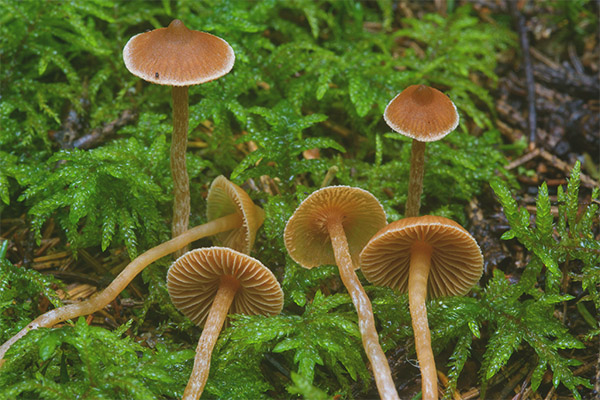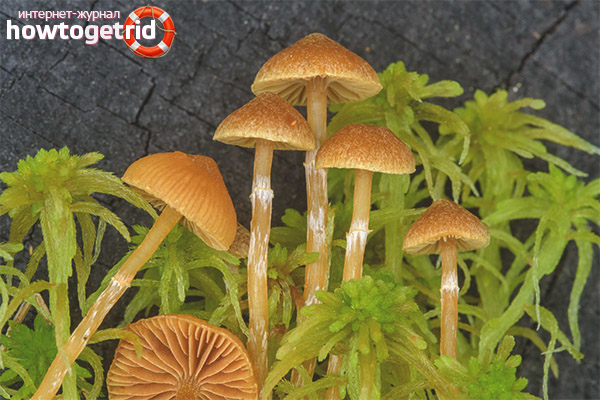The content of the article
The marsh gallery belongs to the stropharium family. It is all good - the appearance with a long elegant leg, pleasant smell, poetic name. But the danger for humans is a very large mushroom, as it provokes the strongest poisoning. Mushroom pickers should know what a dangerous gallery looks like.
Appearance Description
To avoid poisoning, during the collection of mushrooms you need to know what the most toxic mushrooms look like. This includes the marsh galina, very reminiscent of edible mushrooms - to such an extent that even the experience of mushroom pickers can deceive them.
The diameter of the cap of the mushroom is quite small - from 1 to 3 cm, and the shape of the young specimen is conical or convex. But the mushroom grows, and the cap gradually changes, acquiring bell-shaped outlines, and in quite mature age - almost flat. But always in the center one feature will be noticeable - a convex tubercle of a pointed form.
The cap itself is smooth, pleasant, silky, but watery and fragile; it is not difficult to knock it down even with a thin branch. When it rains or a lot of moisture around, the cap begins to swell. A young galina swamp has a whitish filament along its edge. This is a reminder of the shattered blanket.
The color of the surface is yellow, honey-colored or yellow-brown at an early age, and then it begins to change, fade, and becomes a dark yellow color.
Young copies have a plate light brown. During the period of maturation, the dispute begins to darken the plates, as a result they become ohristo-brown, but at the edges the shade turns slightly lighter. Plates can be adhered to the stem, but there are also species where they fall on it. Spores are in the form of broadly ovoid.
The fragile leg is powdery, very long and thin, from 5 and even up to 20 cm with a diameter of 0.1 - 0.5 cm. Inside it is hollow. Compared with a hat it wins in size. Often very straight, even, and only occasionally can be seen with bends.It has a light yellow color, or with a brown or green tint: it all depends on the area in which the fungus grows.
The lower part contains light, almost white areas - here also spiderweb remains of the coverlet remain. The upper part - with a ring of white.
Moss is a favorite habitat
Galerina marsh chose a fibrous area, where there is a large abundance of moss. You can see it most often in wetland forest areas - coniferous or mixed - in Europe and in North America. Places are chosen warm, overgrown, but at the same time - with a lot of constant moisture.
It also grows fungus on stumps or on a rotten tree, especially prefers coniferous. Many mushrooms can be found in the place where there is a large accumulation of rotting wood. The intergrowth does not grow very often, mostly the mushrooms are located nearby, but one by one, the bases of the legs are rarely found together.
Fruiting mushroom is a period from June to September. Especially in August and September, mushroom pickers should be more attentive, since this poisonous mushroom can be found in large quantities.And always remember that he is very poisonous.
Gallery has other types
Bog gallery is not the only one in the family. There are other galleries as well:
- Ribbon At an early age, has a conical cap, which gradually expands more and more, passing the stage from bell-shaped to flat. But the bulge in the center will definitely remain. Color - honey yellow, there are brown stripes. The diameter of the cap is small - from 0.4 cm to 3. The hat is wet, and, when it is especially wet, it immediately begins to swell. The flesh is very thin and rather fragile, with very unexpressed smell and taste. The hollow, flat leg is rather long, ranging from 3 cm to 12, and the diameter does not exceed 0.2 cm. Its color is yellow and light or slightly brownish. But over time, the lower part acquires a dark chestnut color. A distinctive feature is that the ring is most often absent on the leg. It grows in swampy areas where there is a lot of moss. In food is not used.
- Sphagous. The size of its cap can be quite tiny - 0.6 cm, but there are also mushrooms, the cap diameter of which is 3.5 cm. The young mushroom of the cap edge has a fibrous and cone-shaped shape, which over time becomes almost flat.Its surface is either smooth or convex, and the tubercle in the center is more saturated. The leg is also quite long - up to 12 cm. The ring is first there and then it disappears, however, traces of the cover are noticeable. Scientists do not recognize this kind of poisonous, but it does not possess edible qualities.












To send